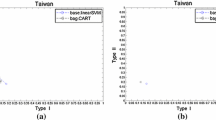Abstract
Financial distress prediction is an important research topic in both academic and practical world. This paper proposed a financial distress prediction model based on similarity weighted voting case-based reasoning (CBR), which consists of case representation, similar case retrieval and combination of target class. An empirical study was designed and carried out by using Chinese listed companies’ three-year data before special treatment (ST) and adopting leave-one-out and grid-search technique to find the model’s good parameters. The experiment result of this model was compared with multi discriminant analysis (MDA), Logit, neural networks (NNs) and support vector machine (SVM), and it was concluded that similarity weighted voting CBR model has very good predictive ability for enterprises which will probably run into financial distress in less than two years, and it is more suitable for short-term financial distress prediction.
This paper is supported by the National Natural Science Foundation of China (No. 70573030) and the National Center of Technology, Policy, and Management, Harbin Institute of Technology.
Preview
Unable to display preview. Download preview PDF.
Similar content being viewed by others
References
Beaver, W.: Financial Ratios as Predictors of Failure. Journal of Accounting Research 4, 71–111 (1966)
Altman, E.I.: Financial Ratios Discriminant Analysis and the Prediction of Corporate Bankruptcy. Journal of Finance 23, 589–609 (1968)
Ohlson, J.A.: Financial Ratios and Probabilistic Prediction of Bankruptcy. Journal of Accounting Research 18, 109–131 (1980)
Odom, M., Sharda, R.: A Neural Networks Model for Bankruptcy Prediction. In: Proceedings of the IEEE International Conference on Neural Network, pp. 163–168 (1990)
Shin, K.-S., Lee, T.S., Kim, H.-J.: An Application of Support Vector Machines in Bankruptcy Prediction Model. Expert Systems with Applications 28, 127–135 (2005)
Min, J.H., Lee, Y.-C.: Bankruptcy Prediction Using Support Vector Machine with Optimal Choice of Kernel Function Parameters. Expert Systems with Applications 28, 128–134 (2005)
Hui, X.-F., Sun, J.: An Application of Support Vector Machine to Companies’ Financial Distress Prediction. In: Torra, V., Narukawa, Y., Valls, A., Domingo-Ferrer, J. (eds.) MDAI 2006. LNCS (LNAI), vol. 3885, pp. 274–282. Springer, Heidelberg (2006)
Schank, R.: Dynamic Memory: A Theory of Learning in Computers and People. Cambridge University Press, New York (1982)
Sankar, K.P., Simon, C.K.S.: Foundations of Soft Cased-Based Reasoning. Wiley, New Jersey (2004)
Hansen, J., McDonald, J., Stice, J.: Artificial Intelligence and Generalized Qualitative Response Models: An Empirical Test on Two Audit Decision Making Domains. Decision Science 23, 708–723 (1992)
Kim, S.H., Noh, H.J.: Predictability of Interest Rates Using Data Mining Tools: A Comparative Analysis of Korea and the US. Expert Systems with Applications 13, 85–95 (1997)
Jo, H., Han, I.: Bankruptcy Prediction Using Case-Based Reasoning, Neural Networks, and Discriminant Analysis. Expert Systems with Applications 13, 97–108 (1997)
Xu, X.Z., Gao, G.-A.: Research and Implement of Case - based Reasoning in an Multi-criteria Evaluation IDSS. Computer Integrated Manufacture System (in Chinese) 7, 16–18 (2001)
Ai, W.-G., Li, H., Sun, J.: Case Based Reasoning Model in a Multi-Criteria Group Intelligent Decision Support System. Journal of Harbin Institute of Technology (in Chinese) 36, 805–807 (2004)
Hsu, C.-W., Chang, C.-C., Lin, C.-J.: A Practical Guide to Support Vector Classification. Technical Report, http://www.csie.ntu.edu.tw/~cjlin/papers/guide/guide.pdf
Author information
Authors and Affiliations
Editor information
Editors and Affiliations
Rights and permissions
Copyright information
© 2006 Springer-Verlag Berlin Heidelberg
About this paper
Cite this paper
Sun, J., Hui, XF. (2006). Financial Distress Prediction Based on Similarity Weighted Voting CBR. In: Li, X., Zaïane, O.R., Li, Z. (eds) Advanced Data Mining and Applications. ADMA 2006. Lecture Notes in Computer Science(), vol 4093. Springer, Berlin, Heidelberg. https://doi.org/10.1007/11811305_103
Download citation
DOI: https://doi.org/10.1007/11811305_103
Publisher Name: Springer, Berlin, Heidelberg
Print ISBN: 978-3-540-37025-3
Online ISBN: 978-3-540-37026-0
eBook Packages: Computer ScienceComputer Science (R0)




